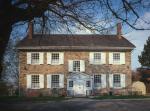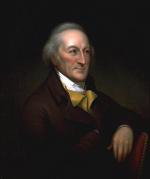![header=[Marker Text] body=[Summer home of Robert Morris, George Clymer, Washington's Hdqrs. Dec. 8-14, 1776.] sign](http://explorepahistory.com/kora/files/1/10/1-A-207-139-ExplorePAHistory-a0h8v2-a_450.jpg)
Mouse over for marker text
Name:
Summerseat (Robert Morris)
Region:
Philadelphia and its Countryside/Lehigh Valley
County:
Bucks
Marker Location:
Legion and Clymer Aves. At site, Legion Ave. near Hillcrest Ave., Morrisville
Dedication Date:
January 27, 1949
Behind the Marker
Located at Morrisville, Bucks County, this two-story Georgian mansion played an important role during the American Revolution. Here General George Washington established his headquarters just weeks before his famous crossing of the Delaware to launch a surprise attack on the Hessians in Trenton in December 1776. At the time, the impressive house was the "summer seat," or home of wealthy Philadelphia financier Robert Morris. Washington stayed at Morris's Philadelphia mansion whenever he was in the city. After he became president in 1789, Washington made Morris his first choice for secretary of the treasury, a position that went to Alexander Hamilton only after Morris decided to serve as Senator from Pennsylvania.
The closeness of Washington and Morris also makes sense because Morris's financial genius was as essential to the success of the American Revolution as Washington's military skills. By 1776, Congress already had recognized the exceptional talents and industry of Morris, a Liverpool-born Philadelphia merchant who in company with his partners Charles Willing and Willing's son Thomas had made a fortune trading to Europe and the West Indies. Congress left Morris in charge of the city of Philadelphia during its absence in 1776 -1777, and as head of that body's Secret Committee of Trade he took charge of obtaining military supplies from Europe that the Continental Army so desperately needed.
Morris became equally essential during the winter of 1780 -1781, a low point in the American Revolution, when the British conquered much of the South, and the Pennsylvania Line, one of the backbones of the Continental army, mutinied. Appointed Superintendent of Finance by unanimous vote of Congress in May of 1781, he, within three days of taking office, proposed the creation of a Bank of North America - modeled on the Bank of England - to save the bankrupt republic from financial collapse. Morris realized that the Bank could attract private capital from the fortunes that merchants and privateers were accumulating during the war, which could then be used to issue paper notes.
issue paper notes.
Morris issued his own "Morris notes" based on his own extensive credit both before and after the Bank was finally chartered on December 31, 1781. The Bank, managed by Morris's partner Thomas Willing, proved a success, paying 8.75 percent annual dividends, maintaining the value of its notes, and providing over $1,200,000 for the American cause. Morris resigned in 1783 when Congress expected him to continue to use his own private credit to fund expenditures the Bank could not: despite his resignation, he still put up as much credit as he could.
Despite Morris's willingness to risk his own funds, powerful opponents were resentful of his accumulation of power and angry that middle-states" merchants had profited greatly from privateering and selling imported goods during the war. As a result, Massachusetts delegates to Congress, led by Samuel Adams, and southerners headed by South Carolina's Henry Laurens accused him of excessive profiting from the war.
Morris also recognized that the Bank could play another role of equal importance. This was "to unite the states more clearly together in general commerce, and to indissolubly attach many powerful individuals to the cause of our country, by the strong principle of self-love and... self-interest." As early as 1781, he had hoped to create an inter-state common interest among those wealthy individuals who deposited money in the Bank or borrowed money from it.
As Pennsylvania prospered in the early 1780s, Morris and his followers persuaded the Pennsylvania legislature to pay off its own state debt and assume the state's share of federal obligations, to offer bounties for technological innovations, and to encourage manufacturing; measures that foreshadowed Alexander Hamilton's national financial program as Secretary of the Treasury in the 1790s. Morris attended the Annapolis Convention in 1786 to support economic cooperation among the states, and was a delegate to the United States Constitutional Convention in 1787, where he chose not to speak. In the mid-1780s, he was also a key figure in societies formed by Philadelphia merchants to further Pennsylvania's industrial and commercial development.
Morris enjoyed great success in putting the new republic's finances on an even keel. In his own financial affairs, however, he was not so fortunate. His downfall was the North American Land Company, into which he and partners John Greenleaf and John Nicholson purchased some six million acres of land in the western parts of the United States from New York to Kentucky, hoping that increased European migration would enable them to sell it at a great profit. When the sales failed to materialize, Morris landed in Philadelphia's Prune Street Jail for debtors, where he remained from February 1798 to August 1801. He died five years later, in poverty and obscurity, neglected by a nation that might have collapsed in its infancy had he not founded its first Bank and assumed control over its finances.
The closeness of Washington and Morris also makes sense because Morris's financial genius was as essential to the success of the American Revolution as Washington's military skills. By 1776, Congress already had recognized the exceptional talents and industry of Morris, a Liverpool-born Philadelphia merchant who in company with his partners Charles Willing and Willing's son Thomas had made a fortune trading to Europe and the West Indies. Congress left Morris in charge of the city of Philadelphia during its absence in 1776 -1777, and as head of that body's Secret Committee of Trade he took charge of obtaining military supplies from Europe that the Continental Army so desperately needed.
Morris became equally essential during the winter of 1780 -1781, a low point in the American Revolution, when the British conquered much of the South, and the Pennsylvania Line, one of the backbones of the Continental army, mutinied. Appointed Superintendent of Finance by unanimous vote of Congress in May of 1781, he, within three days of taking office, proposed the creation of a Bank of North America - modeled on the Bank of England - to save the bankrupt republic from financial collapse. Morris realized that the Bank could attract private capital from the fortunes that merchants and privateers were accumulating during the war, which could then be used to
Morris issued his own "Morris notes" based on his own extensive credit both before and after the Bank was finally chartered on December 31, 1781. The Bank, managed by Morris's partner Thomas Willing, proved a success, paying 8.75 percent annual dividends, maintaining the value of its notes, and providing over $1,200,000 for the American cause. Morris resigned in 1783 when Congress expected him to continue to use his own private credit to fund expenditures the Bank could not: despite his resignation, he still put up as much credit as he could.
Despite Morris's willingness to risk his own funds, powerful opponents were resentful of his accumulation of power and angry that middle-states" merchants had profited greatly from privateering and selling imported goods during the war. As a result, Massachusetts delegates to Congress, led by Samuel Adams, and southerners headed by South Carolina's Henry Laurens accused him of excessive profiting from the war.
Morris also recognized that the Bank could play another role of equal importance. This was "to unite the states more clearly together in general commerce, and to indissolubly attach many powerful individuals to the cause of our country, by the strong principle of self-love and... self-interest." As early as 1781, he had hoped to create an inter-state common interest among those wealthy individuals who deposited money in the Bank or borrowed money from it.
As Pennsylvania prospered in the early 1780s, Morris and his followers persuaded the Pennsylvania legislature to pay off its own state debt and assume the state's share of federal obligations, to offer bounties for technological innovations, and to encourage manufacturing; measures that foreshadowed Alexander Hamilton's national financial program as Secretary of the Treasury in the 1790s. Morris attended the Annapolis Convention in 1786 to support economic cooperation among the states, and was a delegate to the United States Constitutional Convention in 1787, where he chose not to speak. In the mid-1780s, he was also a key figure in societies formed by Philadelphia merchants to further Pennsylvania's industrial and commercial development.
Morris enjoyed great success in putting the new republic's finances on an even keel. In his own financial affairs, however, he was not so fortunate. His downfall was the North American Land Company, into which he and partners John Greenleaf and John Nicholson purchased some six million acres of land in the western parts of the United States from New York to Kentucky, hoping that increased European migration would enable them to sell it at a great profit. When the sales failed to materialize, Morris landed in Philadelphia's Prune Street Jail for debtors, where he remained from February 1798 to August 1801. He died five years later, in poverty and obscurity, neglected by a nation that might have collapsed in its infancy had he not founded its first Bank and assumed control over its finances.







